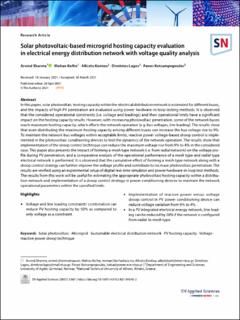| dc.contributor.author | Sharma, Arvind | |
| dc.contributor.author | Kolhe, Mohan Lal | |
| dc.contributor.author | Kontou, Alkistis | |
| dc.contributor.author | Lagos, Dimitrios | |
| dc.contributor.author | Kotsampopoulos, Panos | |
| dc.date.accessioned | 2022-04-20T12:53:58Z | |
| dc.date.available | 2022-04-20T12:53:58Z | |
| dc.date.created | 2021-04-21T09:30:49Z | |
| dc.date.issued | 2021 | |
| dc.identifier.citation | Sharma, A., Kolhe, M.L., Kontou, A., Lagos, D. & Kotsampopoulos, P. (2021) Solar photovoltaic‑based microgrid hosting capacity evaluation in electrical energy distribution network with voltage quality analysis SN Applied Sciences. 2021, 3 . | en_US |
| dc.identifier.issn | 2523-3963 | |
| dc.identifier.uri | https://hdl.handle.net/11250/2991661 | |
| dc.description.abstract | Part of a collection: Engineering: Integrated Sustainable Electrical Energy Systems, SN Applied Sciences volume 3, Article number: 567 (2021). Abstract: In this paper, solar photovoltaic hosting capacity within the electrical distribution network is estimated for different buses, and the impacts of high PV penetration are evaluated using power hardware-in-loop testing methods. It is observed that the considered operational constraints (i.e. voltage and loadings) and their operational limits have a significant impact on the hosting capacity results. However, with increasing photovoltaic penetration, some of the network buses reach maximum hosting capacity, which affects the network operation (e.g. bus voltages, line loading). The results show that even distributing the maximum hosting capacity among different buses can increase the bus voltage rise to 9%. To maintain the network bus voltages within acceptable limits, reactive power voltage-based droop control is implemented in the photovoltaic conditioning devices to test the dynamics of the network operation. The results show that implementation of the droop control technique can reduce the maximum voltage rise from 9% to 4% in the considered case. This paper also presents the impact of forming a mesh type network (i.e. from radial network) on the voltage profile during PV penetration, and a comparative analysis of the operational performance of a mesh type and radial type electrical network is performed. It is observed that the cumulative effect of forming a mesh type network along with a droop control strategy can further improve the voltage profile and contribute to increase photovoltaic penetration. The results are verified using an experimental setup of digital real-time simulator and power hardware-in-loop test methods. The results from this work will be useful for estimating the appropriate photovoltaic hosting capacity within a distribution network and implementation of a droop control strategy in power conditioning devices to maintain the network operational parameters within the specified limits. | en_US |
| dc.language.iso | eng | en_US |
| dc.rights | Navngivelse 4.0 Internasjonal | * |
| dc.rights.uri | http://creativecommons.org/licenses/by/4.0/deed.no | * |
| dc.title | Solar photovoltaic‑based microgrid hosting capacity evaluation in electrical energy distribution network with voltage quality analysis | en_US |
| dc.type | Journal article | en_US |
| dc.type | Peer reviewed | en_US |
| dc.description.version | publishedVersion | en_US |
| dc.rights.holder | © 2021 The Author(s) | en_US |
| dc.subject.nsi | VDP::Technology: 500 | en_US |
| dc.source.pagenumber | 22 | en_US |
| dc.source.volume | 3 | en_US |
| dc.source.journal | SN Applied Sciences | en_US |
| dc.identifier.doi | 10.1007/s42452-021-04543-2 | |
| dc.identifier.cristin | 1905469 | |
| cristin.qualitycode | 1 | |

